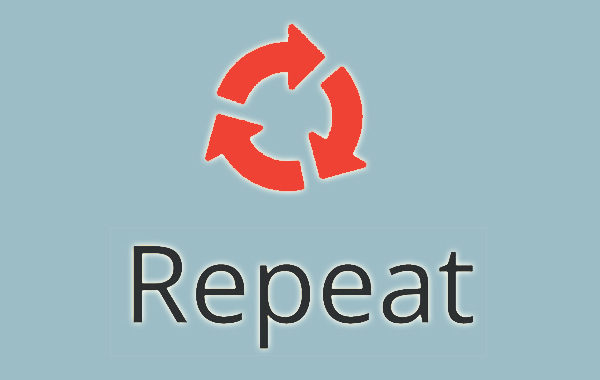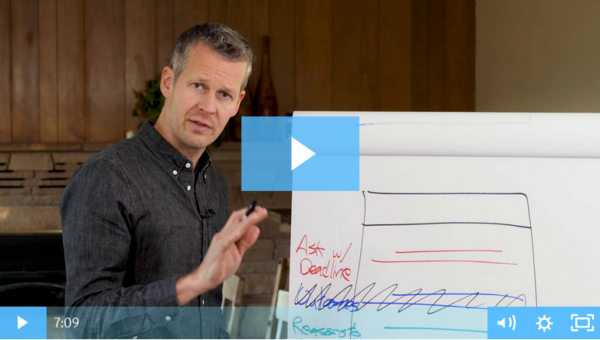I know the idea of “repeating” fundraising you’ve done before doesn’t make sense at first. And it can feel weird.
That’s why I want to talk about the secret of “repeating” – just think of it as a tool that savvy fundraisers use to save time and (surprisingly) raise more money.
What We Mean By “Repeat”
When we say you can “repeat” something, here’s what we mean in a nutshell: do the same thing again, but slightly differently.
- Send the same letter again, but slightly reword it
- Send the same email again, but slightly reword it
- Run the same event again, but with a different beneficiary speaker
- Send the same letter again, but with a slightly different design
Are you picking up what I’m laying down?
And in some cases you can send the exact same thing. Same email. Same letter. We’ve done both of them and they’ve both worked:
- My podcast partner Jeff Brooks tells a story about an organization that sent an appeal every month. One month it accidentally sent out the exact same appeal that it sent the previous month – and it raised more money the second time!
- I think about an organization that took half their donors and sent them the same exact email the last four days of the year. Those donors gave more than the other half of their donors who received four unique emails.
Because remember:
- Most of your donors aren’t paying that close attention
- Many donors need to hear something twice (or more) before they pay attention and really think about it
When To Repeat Letters And Emails
Here’s how to repeat your appeal letters and your emails.
If you are doing something that you did the year before, you can repeat it.
Say you send out a Thanksgiving appeal last year, and you’re going to do another one this year. The first thing to do is to look at last year‘s Thanksgiving appeal and its results.
If the results were better than the previous year, repeat it. Don’t write a completely new email. Don’t design a completely new letter. Make only the minimal number of changes you need to make.
The same is true for anything you do each year. Here’s a list of things we’ve repeated to great success, and I’m sure there are more examples:
- Year-end / Thanksgiving / Back-to-School / etc. – letters & emails
- Facebook campaigns
- Events
- Giving Tuesday
- Renewal
- 13th Gift
- Sponsorship/monthly giving upgrade campaigns
- Monthly giving recruitment
You name it. If you do it every year, you should be repeating it and making slight tweaks to make it better, not reinventing the wheel.
When You Repeat, Watch Out For…
Here’s what to watch out for when you’ve decided to repeat a fundraising tactic…
- Any detail that was true last year, but not this year. You need to update anything that’s not true. New ED? Update the name at the end of the letter. This year’s “Thanksgiving Meal” costs $1.93 instead of $1.92? Update the letter. Your organization now rescues Wombats? Add “wombats” to the list of animals you rescue.
- Does the story need to be updated? Many letters contain a story about a person that illustrates the need. That story should be swapped out and replaced with a new story. But the rest of the letter doesn’t have to change.
- Note: this is true for events as well.
- Doing too much. Don’t make too many changes just because you’re in there.
Story Time With Steven
I used to write appeal letters and emails for The Salvation Army. They are a fundraising machine who has all of this down to a science. (You might read that they are a “fundraising machine” and think, “Well, that would never work with my donors.” Please be open to the idea that it would work. Many of your donors also give to the Army.)
Most of the time I would receive the following instructions when it was time to write a letter:
“Here’s last year’s letter. It worked great. Update it for this year and change only what’s absolutely necessary. Do not mess this up.”
Inspiring!
No, not really. At least if you’re a ‘creative type’ like me.
But that’s how you build a mature fundraising program that raises the big bucks. You take something that works. You repeat it. You refine it. You look for little ways to make it better. You watch the results closely and look for what donors love, as told through their giving.
Over time you build a money-raising machine that allows you to do so much good in the world that people come to learn fundraising from you.
Listen, a lot of people don’t like hearing this. They want to be creative. They want to love the fundraising they send out.
I’m the same way. I get bored writing the same emails for the second (or tenth) year in a row.
But over time, if you look at the results, it becomes really obvious that if you repeat what worked before, you’re going to raise more money.
Please trust me – I’ve banged my head against that wall enough time to have a small dent in the middle of my forehead. (Well, actually that scar is from my sister throwing a Hot Wheel at me, but it’s a better story if it’s a fundraising scar.)
You are going to be tired of what you’ve been doing. So will your boss and your Board. You’re going to want to do it differently. You’re going to want to ‘come up with a new theme for this year’!
Don’t give in. Keep doing what’s been working great. You’ll raise more money each year.
If you invent a new approach each year you’ll be causing two problems: #1, you’ll be raising less money; and #2, you’ll be taking a LOT of time you could be using to do something else. Like, you know, focusing on major donors, where 90% of your individual donations come from. Or acquiring new donors, who are the future of your organization.
But Whither Innovation?
I’m going to write a post later this month on ‘how to innovate when you’re in a culture of repeating what’s worked in the past.’ Because you have to innovate.
But you want to innovate in a way that minimizes your risk. And I’ll share how to do that. But here’s an analogy to tide you over…
If you’re Apple, do you decide to stop making the iPhone and replace it with something completely new? No. You keep on updating, tweaking the iPhone to make it better each year. And you keep releasing different versions of the iPhone to try out new ideas.
Sheesh
Enough rambling. I hope the concept of “repeating” is making sense. I know it’s not how normal nonprofits operate. But it’s one of the secrets that savvy fundraisers have discovered – and you should be using it. You’ll save time, and you’ll raise more money.
If you’d like to have me help your organization know what to repeat – or to tweak what you’re doing to make it even better – get in touch!
This post was originally published on June 7, 2018.





